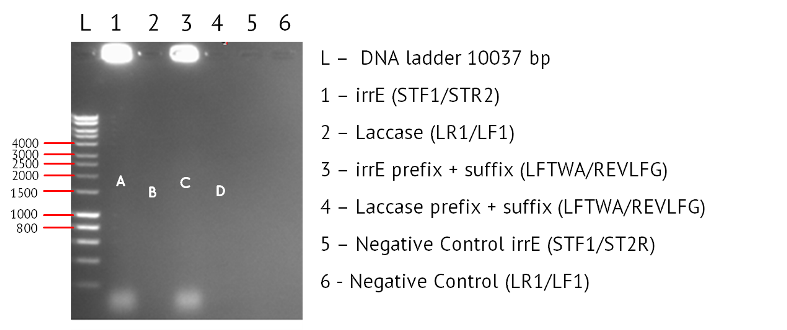Team:University College London/LabBook/Week10
From 2012.igem.org
Rwilkinson (Talk | contribs) (→Wednesday 15.08.12) |
Sednanalien (Talk | contribs) |
||
| Line 64: | Line 64: | ||
'''Step 1 - Setting up PCR tubes:''' The polymerase used was Phusion, and we had two template DNAs – irrE and Laccase. | '''Step 1 - Setting up PCR tubes:''' The polymerase used was Phusion, and we had two template DNAs – irrE and Laccase. | ||
| - | |||
| - | |||
<html></div> | <html></div> | ||
<div class="experiment"></div> | <div class="experiment"></div> | ||
<img id="9-4" src="https://static.igem.org/mediawiki/2012/2/2b/Ucl2012-labbook-graph109-4.png" /><div class="experimentContent"> | <img id="9-4" src="https://static.igem.org/mediawiki/2012/2/2b/Ucl2012-labbook-graph109-4.png" /><div class="experimentContent"> | ||
</html> | </html> | ||
| - | |||
== 9-4 == | == 9-4 == | ||
<html> | <html> | ||
</div><div class="experiment"></div></html> | </div><div class="experiment"></div></html> | ||
| - | |||
<img id="10-1" src="https://static.igem.org/mediawiki/2012/e/ee/Ucl2012-labbook-graph10-1.png" /><div class="experimentContent"> | <img id="10-1" src="https://static.igem.org/mediawiki/2012/e/ee/Ucl2012-labbook-graph10-1.png" /><div class="experimentContent"> | ||
</html> | </html> | ||
Revision as of 11:37, 24 August 2012



Contents |
Tuesday 14.8.12
Aim - Repeat experiment 9.2: We think there might have been a confusion in preparing the samples for the PCR because we did not obtain any bands on the gel for irrE or Laccase.
Method
Step 1 - Setting up PCR tubes: Thaw reagents and add to PCR tubes in the proportions described in the table below
| PCR Components | Volume (ul) |
|---|---|
| 5x Reaction Buffer | 10 |
| 25mM MgCl2 | 4 |
| 10mM dNTPs | 1 |
| 10uM Forward primer | 5 |
| 10uM Reverse primer | 5 |
| DNA Polymerase | 0.25 |
| Nuclease Free Water | 24.25 |
| Template DNA | 0.5 |
| Total Volume | 0.5 |
Step 2 - PCR program: Add PCR tubes to a thermocycler and run under the following conditions.
| PCR conditions | Temp (oC) | Time (s) |
|---|---|---|
| Initial Denaturation (1 cycle) | 95 | 30 |
| Denaturation/Annealing/Extension (30 cycles) | 95/55/72 | 10/25/120 |
| Final Extension (1 cycle) | 72 | 600 |
| Hold | 4 | ∞ |
Step 1 - Setting up PCR tubes: The table below gives the identity of the primers used for each reaction. It indicates the samples that were set up for the repeat of Expt 9.2, as was done in the first attempt of Expt 9.2.
| DNA Template | Function | Module | Primer Pair | Primer | Primer Sequence |
|---|---|---|---|---|---|
| BBa_K729002 | Laccase Gene | Degradation | LR1/LF1 | LR1 | gaatacggtctttttataccg |
| LF1 | gaaataactatgcaacgtcg | ||||
| REVLF2/LFTW0 | REVLF2 | gtttcttcctgcagcggccgctactagtagaatacggtctttttataccg | |||
| LFTW0 | gtttcttcgaattcgcggccgcttctagaggaaataactatgcaacgtcg | ||||
| No Template (Negative Control) | N/A | Degradation | LR1/LF1 | LR1 | gaatacggtctttttataccg |
| LF1 | gaaataactatgcaacgtcg | ||||
| BBa_K729001 | irrE | Salt Tolerance | STF1/ST2R | STF1 | atggggccaaaagctaaagctgaagcc |
| ST2R | tcactgtgcagcgtcctgcg | ||||
| STF3/ST4R | STF3 | gtttcttcgaattcgcggccgcttctagagatggggccaaaagctaaagctgaagcc | |||
| ST4R | gtttcttcctgcagcggccgctactagtatcactgtgcagcgtcctgcg | ||||
| No Template (Negative Control) | N/A | Salt Tolerance | STF1/STF2 | STF1 | atggggccaaaagctaaagctgaagcc |
| ST2R | tcactgtgcagcgtcctgcg |
Results: The image below shows a 1% Agarose Gel of an Analytical Restriction Enzyme Digest for Expt 9.2, with a 1000bp ladder. Again we have not obtained any bands. In Lanes 1 and 3 we expected a product corresponding to the size of the irrE gene (1974bp) as indicated by A and C respectively. C would be marginally larger because it also contains the standard BioBrick prefix and suffix, but this different would not be noticeable on a gel. In Lane 2 and 4 we would expect products corresponding to the size of the Laccase gene (1554bp), as shown by B and D. Again we would expect D to be a slightly larger product because the primers were designed to include the prefix and suffix, but this is not a difference we would expect to detect. The strong patches of white demonstrate to us that our DNA template is at a high concentration, and should be diluted before we attempt any repeats. The lack of any products suggest we need to reconsider the protocol. Revising the annealing temperature or designing new primers will have to be considered.

Conclusion: We will revise the protocol to see if we can detect any bands.
Wednesday 15.08.12
Aim - Repeat the PCR again to optimise results: As an improvement we are using: - Phusion polymerase - Diluting the irrE DNA 10-fold, due to the excessive dose on DNA shown on the gel from yesterday. - Changing the annealing temperature from 55C to 57C
Method
Step 1 - Setting up PCR tubes: Thaw reagents and add to PCR tubes in the proportions described in the table below
| PCR Components | Volume (ul) |
|---|---|
| 5x Reaction Buffer | 10 |
| 25mM MgCl2 | 4 |
| 10mM dNTPs | 1 |
| 10uM Forward primer | 5 |
| 10uM Reverse primer | 5 |
| DNA Polymerase | 0.25 |
| Nuclease Free Water | 24.25 |
| Template DNA | 0.5 |
| Total Volume | 0.5 |
Step 2 - PCR program: Add PCR tubes to a thermocycler and run under the following conditions.
| PCR conditions | Temp (oC) | Time (s) |
|---|---|---|
| Initial Denaturation (1 cycle) | 95 | 30 |
| Denaturation/Annealing/Extension (30 cycles) | 95/55/72 | 10/25/120 |
| Final Extension (1 cycle) | 72 | 600 |
| Hold | 4 | ∞ |
Step 1 - Setting up PCR tubes: The polymerase used was Phusion, and we had two template DNAs – irrE and Laccase.

9-4
 " />
" /></html>
10-1
 "
"